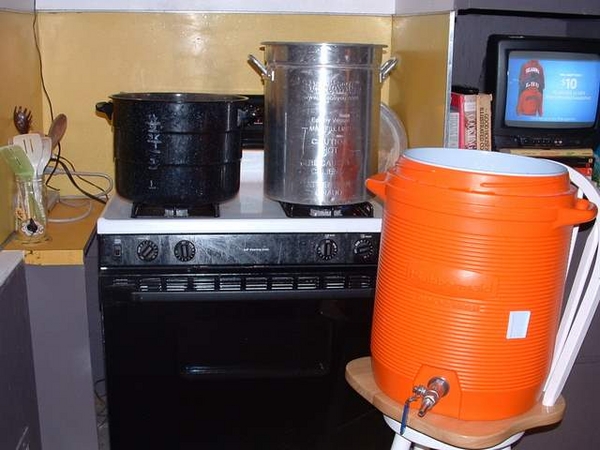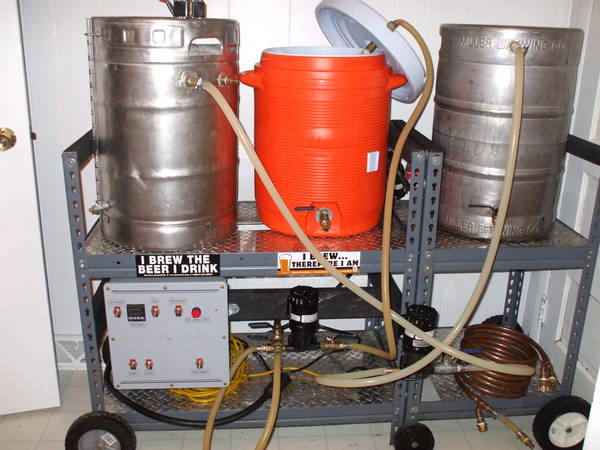Beezy
Well-Known Member
I just got done doing a full boil inside on the stove. No freezing for me. All grain inside = no problem.

I will probably never go into all grain. I prefer the ability to do partial boils inside and with the NY winters, I don't want to freeze my butt off outside! One of my neighbors does all grain and simply does not brew during the winter. I'd never! Also, my free time is limited, and I'd rather not spent that much time on anything.


You are right, at least from everyone's responses I've seen in the past. I've not yet done an AG batch, heck I started brewing less than a year ago and took a break over the summer due to too high temps in the house to ferment. From what I gather there's some more equipment but overall the supplies are cheaper so in the even short run AG is cheaper.
However, I've never compared bulk extract to bulk grain costs but I'm pretty sure bulk grain is cheaper, it has to be - extract includes the service charge for the conversion no? Makes sense really.
My thinking though is some of the bulk cost of brewing for me is yeast. If I get into harvesting yeast I can save the most money overall. Either way, extract or AG I am saving a bunch more money brewing at home as opposed to buying commercial brew.
Rev.
I hear you on the yeast. I just pitch Safale dry and I'm still looking at cutting that cost. I haven't found very much information on the step by step process of saving and reusing yeast yet..



![Craft A Brew - Safale S-04 Dry Yeast - Fermentis - English Ale Dry Yeast - For English and American Ales and Hard Apple Ciders - Ingredients for Home Brewing - Beer Making Supplies - [1 Pack]](https://m.media-amazon.com/images/I/41fVGNh6JfL._SL500_.jpg)








I don't mean to high jack the thread, but what is this "no chill" that I keep hearing????

OK. You guys have thrown me for a loop on this on. Doesn't go against everything taught that the wort must be brought down in temp as quickly as possible to eliminate off flavors? Then why spend all the money on chillers? I realize that it is a convienence to get it all done in one day, but I like the idea of splitting up the process in half over two days. Many a late night / early morning I have spent cursing the temp Gods trying to get down to pitching range! Are there any beers that are better to do this with and ones that I should stay clear of?
Wheat ales, stouts and any dark or naturally cloudy ales would seem the most appropriate. I have seen some people that no chill and have fantastically clear beers, though none of mine have turned out that way. I am not so worried about the appearance of my beer, just the flavour and so far each have turned out great. I have done two pale ales, one Belgian strong and two blonde ales. I have one more blonde fermenting away now. No off flavours at all, but I tend to due boils over 60 minutes to kill any possible DMS flavours.
I have read a couple other brewers that had a lot of trouble no chilling IPA's. Their experiences were that even with the modified hop schedule the beer ended up extremely bitter, so much so that it ruined the beer. I have not tried an IPA yet myself so I cannot confirm this.
The beer probably got infected, which is the biggest risk you take by not chilling your beer quickly. That was a lesson I learned when I first started brewing. I let a batch cool slowly overnight. The beer was extremely bitter. And not the type of bitterness you get from hops. It was really awful tasting.
Honestly I wouldn't recommend doing this. In my experiences my beers improved dramatically (in flavor and appearance) once I started rapidly chilling the wort right after flameout.

I really don't want high jack this thread and turn it into a no chill vs. chill debate, there are enough of those already on this forum. No chill is very common place in Australian brewing, so its not like there is only a handful of crazy no chill rebels out there. I plan to continue to to no chill my beers (which outside of cloudiness turn out fine, if not fantastic tasting) until the day I feel that its is actually impacting my beers flavour or I find I get an infection from it (so far the number is 0).
I cannot say for sure if those others had infections, but from what I read that was not the case. Also what type of infection only creates additional bitterness? (Not arguing there is no bacteria that does this, but I am not sure which one it is). Feel free to PM me if you want to take this offline.
Astringency caused by a bacterial infection would cause extreme bitterness in a beer.
Don't take what I posted the wrong way. I wasn't trying to knock your process. I'd never do that. I'm an extract w/grains/partial mash brewer, and I hate when people try to put down extract brewing.
If the no-chill method works for you then by all means stick with it.